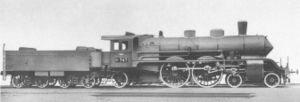Badische II d
| Baden IId | |
|---|---|
|
No. 747, company photo
|
|
| Numbering: | 733-750 |
| Manufacturer: | Maffei , MBG Karlsruhe |
| Year of construction (s): | 1902 + 1905 |
| Retirement: | until 1925 |
| Axis formula : | 2'B1 'n4v |
| Length over buffers: | 20,905 mm 21,015 mm (2nd series) |
| Empty mass: | 68.10 t |
| Service mass: | 75.70 t |
| Friction mass: | 33.30 t |
| Wheel set mass : | 16.70 t |
| Top speed: | 110 km / h (144 km / h) |
| Coupling wheel diameter: | 2,100 mm |
| Impeller diameter front: | 990 mm |
| Rear wheel diameter: | 1,200 mm |
| Control type : | Heusinger |
| Number of cylinders: | 4th |
| HD cylinder diameter: | 335 mm |
| LP cylinder diameter: | 570 mm |
| Piston stroke: | 620 mm |
| Boiler overpressure: | 16 bar |
| Number of heating pipes: | 274 |
| Heating pipe length: | 4,800 mm |
| Grate area: | 3.87 m² |
| Radiant heating surface: | 13.60 m² |
| Tubular heating surface: | 196.40 m² |
| Superheater area : | 210.00 m² |
| Locomotive brake: | Westinghouse |
The class II d steam locomotives of the Grand Ducal Baden State Railway were express locomotives built by the Maffei company in Munich. When they first appeared in 1902, they were the largest express train locomotives in Europe.
The service program stipulated that a speed of 100 km / h was to be driven on an incline of 3.3 per thousand and a train of 200 t. Of the seven submitted designs, Maffei was ultimately awarded the contract.
In April 1904 an II d reached a top speed of 144 km / h and an average of 116 km / h over 62.5 km during a test drive between Offenburg and Freiburg im Breisgau with a train made up of four cars (138 t). This was a German record for steam locomotives, but it was surpassed by the Bavarian S 2/6 as early as 1907 . Unlike the S 2/6, however, the II d was a series locomotive and not a test type specially designed for high-speed travel. The II d remained the fastest German Atlantic , even if the Prussian S 7 came very close to it at 143 km / h.
A total of twelve machines (No. 733-744) were built in 1902 by Maffei and six (No. 745-750) in 1905 by MBG Karlsruhe. One was scrapped in 1903 after an accident. The locomotives were stationed in Offenburg and served the heavy express train service. The daily mileage was over 700 km, which means that around 140,000 km were accumulated annually. After the First World War , ten of them went to France as reparations , where they were given the numbers 221-901 to 221-910 by the Chemins de fer de l'État .
For the Deutsche Reichsbahn , the remaining seven copies with the numbers 14 401–14 403 and 14 451–14 454 were planned according to a preliminary re-drawing plan; However, it was no longer redesigned, as all II ds had already been retired by 1925. In France, however, the locomotives lasted until 1934.
The machines had an internal sheet metal frame. The long boiler consisted of five shots. The smoke chamber door was made strongly conical. The locomotives of the mechanical engineering company Karlsruhe were given a so-called "flower pot" chimney, which, however, worsened the appearance of the locomotives. The four-cylinder wet steam engine drove the first coupled axle. All cylinders were in a transverse plane. The rear axle was designed as a resettable Adam axle . The lateral mobility was 25 mm. The cab had a wind chute. The locomotives were a Tender equipped to type 2'2 'T 20th
literature
- Hermann Lohr, Georg Thielmann: Baden Locomotive Archive (= Railway Vehicle Archive 2, 7). transpress et al., Berlin 1988, ISBN 3-344-00210-4 .

